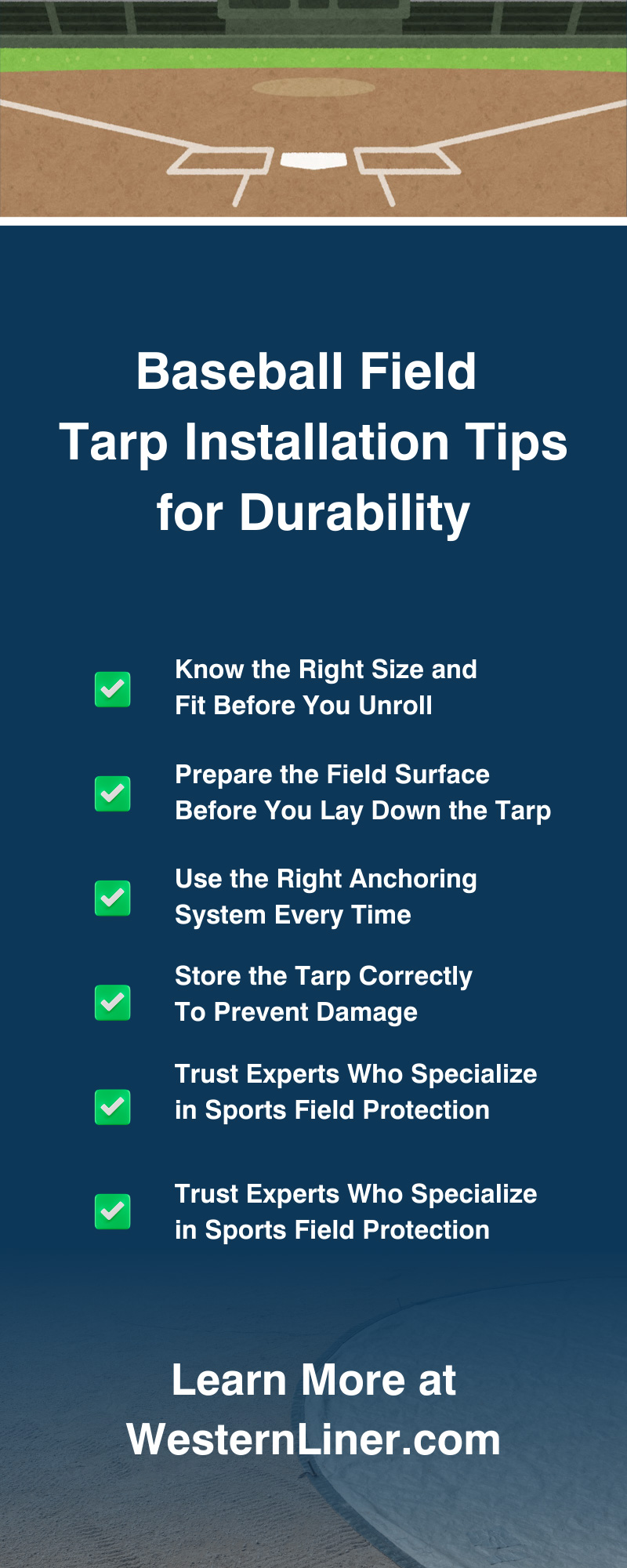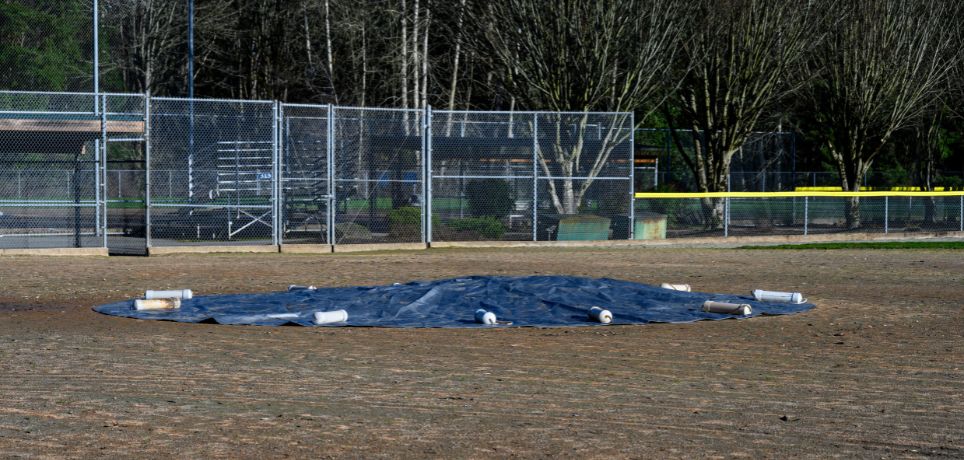Rainstorms never announce their arrival politely. When clouds roll in during a doubleheader or right before a tournament, a high-quality tarp becomes the only thing standing between playable turf and a flooded mess.
Baseball field managers already know one truth: proper installation determines whether the tarp holds or fails. Comprehensive coverage always begins with smart planning and an eye for detail.
Know the Right Size and Fit Before You Unroll
No universal tarp exists for every ballfield, so measuring the playing surface precisely matters. Infield diamonds, bullpen zones, and baselines vary by venue, especially in multipurpose municipal fields. Stretching an undersized tarp too far across a wet surface adds tension at the seams and tears the material prematurely.
A tarp that extends beyond basepaths offers far more protection than one that barely touches the cutout edges. Irregular shapes like softball infields or upgraded clay mounds often require custom dimensions. Teams that settle for default sizes face sagging edges, water pooling, and wasted effort each time the weather shifts.
Grommet spacing also ties directly to fit quality. A tarp with poorly spaced grommets may flutter in the wind and catch on fence lines or anchor pegs, tearing faster than one designed with consistent intervals. Selecting a layout that accommodates turf anchors and reduces stress at connection points allows for tighter, longer-lasting coverage.
Many turf managers overlook wind flap zones until the first storm hits. Strong gusts funnel under loose corners, fold the material over, and expose the soil to standing water. Smart sizing choices remain one of the most important tips for durable baseball field tarp installation when building a reliable coverage plan.
Prepare the Field Surface Before You Lay Down the Tarp
Lumpy, rock-covered dirt beneath a tarp causes small punctures to multiply with each deployment. Clearing away leaves, turf debris, and pebbles before rollout prevents long-term fabric damage that creeps in slowly. Even soft clods of dirt can press through over time and create weak points under sustained pressure.
Moisture trapped between tarp layers and infield soil turns into a breeding ground for mold or rot. Managers who lay tarps over soggy clay invite foul odors, sticky folds, and health hazards for athletes. Waiting for dry conditions or dragging wet spots out with absorbent rollers creates a better base for a clean installation.
Field technicians can speed up storm response time by placing prefilled sandbags at tarp edge zones ahead of rain. Setting anchors near base lines, outfield cut-ins, and home plate reduces time lost searching for equipment once clouds roll in. Anchors stored in labeled bins along fence lines help prevent chaos during weather events.
Rolling the tarp slowly over the cleared surface helps detect raised objects before the weight presses them through. Staff can spot snags as they occur instead of after fabric damage has already taken hold. Small steps like sweeping and staging bags make installation smoother while extending product life.
Use the Right Anchoring System Every Time
Choosing the correct anchoring method protects field tarps from more than just a stray gust of wind. Some venues prefer weighted edge systems that press evenly without sharp points, while others depend on perimeter grommets that hook into fixed posts. Each method works, but only when deployed with consistency across the full tarp span.
Grommets placed too far apart can lead to bowing, sagging, or flapping that stresses the seam threads and tears edges loose. Technicians must run ropes or bungees from every attachment point, not just corners, to maintain surface tension evenly. Skipping anchor points may save time upfront but guarantees mid-season replacements down the road.
Fast-attach clips help speed up response during quick showers, but not every clip system works well for all tarp materials. Some fabrics stretch or deform under clip pressure, especially along uneven fence lines. Careful planning around how anchors interact with tarp texture prevents strain on reinforced seams and coated backing.
Crews that position sandbags at every grommet, rather than only at corners, prevent wind from lifting tarp edges during severe weather. Matching all bungee cords in length and elasticity maintains uniform tension, which protects seams from uneven pulling. Following tips for durable baseball field tarp installation such as full-edge sandbag anchoring and standardized cord setups prevent seam tearing and extend tarp life through repeated storm exposure.
Store the Tarp Correctly To Prevent Damage
Proper tarp storage begins with a clean, dry roll at the end of each use. Folding creates sharp creases that grind against each other while in storage, weakening waterproof coatings and causing fraying. Creased areas might split open during future deployments, especially under heavy rain or wind pressure.
Storage bins mounted above ground level help keep moisture, pests, and rust away from tarp edges. Leaving fabric on wet floors or crammed inside wire cages shortens its useful lifespan. Some teams build custom PVC tubes or rolling carts designed to fit their specific tarp width for safe handling.
Identifying wear before it spreads saves future budget headaches. Staff should check for peeling coating, exposed threads, or pinholes in sunlight at least once per season. Spot repairs using commercial patch kits preserve performance when applied early enough.
Off-season tarp storage routines set the tone for durability during spring play. Sports departments that treat tarp care seriously avoid last-minute surprises in front of crowds or cameras. Long-lasting field protection often comes down to basic routines performed correctly every time.
Trust Experts Who Specialize in Sports Field Protection
Commercial-grade sports facilities rely on tarps to prevent expensive field recovery costs and game cancellations. Our solutions match those demands with reinforced fabric, heat-welded seams, and grommet options that match your preferred anchoring setup. When weather threatens your schedule, field crews shouldn’t worry about whether the tarp will hold.
Our team at Western Environmental Liner partners with athletic programs across the country to build field covers that work season after season. We offer custom-fit tarps for softball fields, training complexes, and more for fields that need reliable protection against unpredictable weather. Our customers include school districts, sports authorities, and parks departments who depend on us to keep facilities open and playable.
With layout specs, wind exposure, and access limitations for each tarp, our crew understands what field managers need. We offer tarps with quick deployments, minimal wear, and zero gaps in coverage. Tarps that barely last one season don’t belong in competitive venues, which is why we focus on reinforcement, weight balance, and UV protection.
We stand behind every tarp that we send out; we’re always ready to help field managers choose a better fit for their location. Softball fields, youth leagues, or major ballparks all benefit from customized covers that are long-lasting and that users can install easily. No matter the field size, Western Environmental Liner delivers protection that plays through anything.
Reliable baseball field protection doesn’t happen by accident. Working with specialists like Western Environmental Liner simplifies everything from sizing to storm prep. Contact us today to get a custom tarp solution built for durability and daily use.



